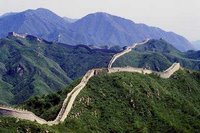Who started construction on the Great Wall of China?
 Turns out, the man who began the wall was fond of large projects. Around 220 B.C.E., Qin Shi Huang unified much of China, as well as conceiving of what would be later known as the Great Wall of China. He is often called China's first emperor, and his name "Qin" or "Ch'in" influenced the country's name.
Turns out, the man who began the wall was fond of large projects. Around 220 B.C.E., Qin Shi Huang unified much of China, as well as conceiving of what would be later known as the Great Wall of China. He is often called China's first emperor, and his name "Qin" or "Ch'in" influenced the country's name.Emperor Qin connected a series of earthworks forming a few smaller walls along the border, with the goal of keeping out invaders. He reinforced these walls and conscripted peasants and others to build the start of the Great Wall. Later rulers continued to reinforce and add onto the wall, often with forced labor. Construction lasted for more than 2,000 years and when it was done, the wall stretched an astounding 4,000 miles (6,700 kilometers).
Emperor Qin is also known for his elaborate tomb filled with life-size terra-cotta warriors. Over 7,000 pottery soldiers, horses, chariots, and other artifacts were buried with Qin, and the mausoleum wasn't discovered until 1974.
Receive post updates by Email



























 Add my feed to your Rss
Add my feed to your Rss
